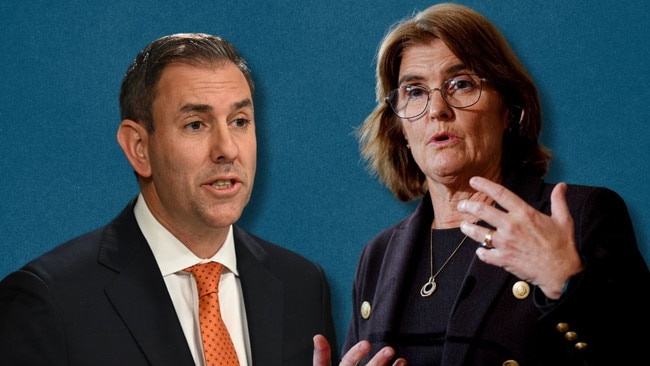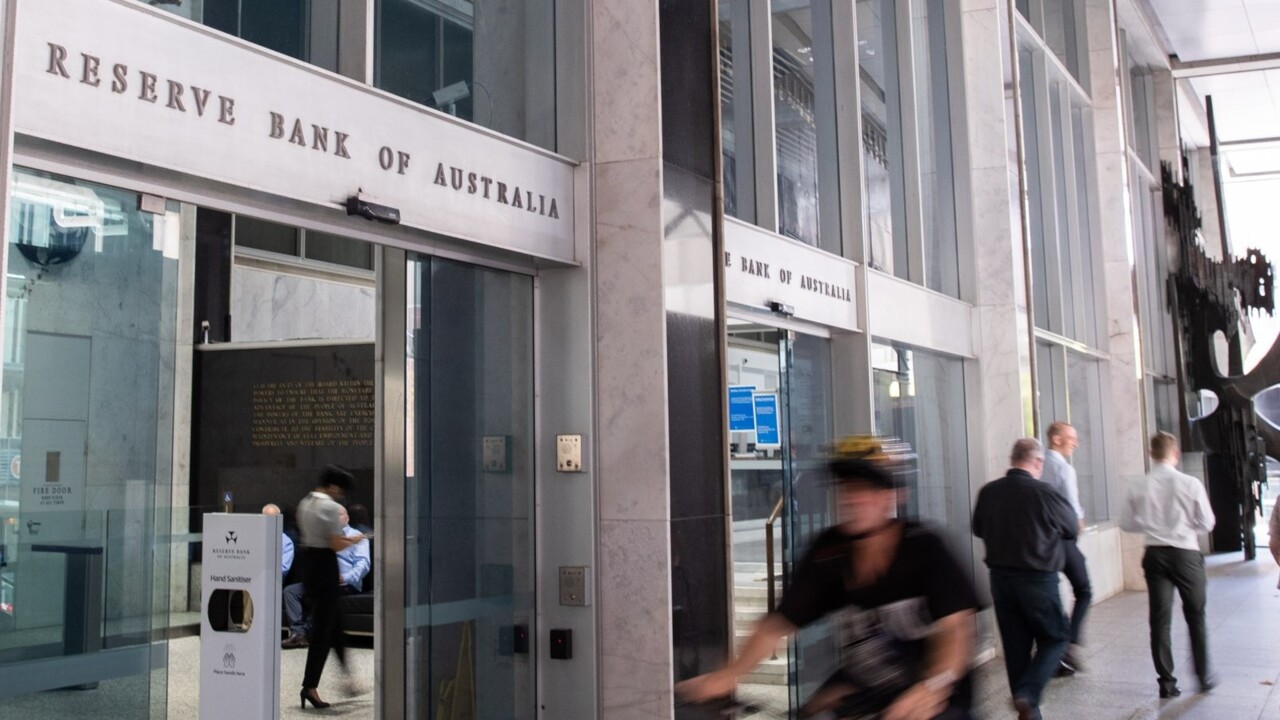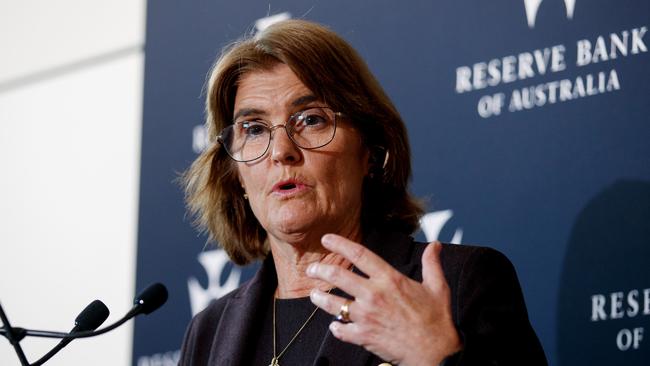Jim Chalmers on the defensive as RBA raises alarm over big-spending budgets
Michele Bullock says ‘we need a lot to go our way’ to bring inflation under control, as the board for the first time flagged big spending budgets may be making its job harder.

Reserve Bank governor Michele Bullock says “we need a lot to go our way” to bring inflation back under control without having to hike interest rates again, as the central bank board for the first time flagged big spending budgets may be making its job harder.
The RBA board held its official cash rate target at a 12-year high of 4.35 per cent for the fifth straight meeting, but the good news for struggling mortgage holders was overshadowed by Ms Bullock’s grim language about an increasingly uncertain outlook.
At a press conference in Sydney following Tuesday’s decision, Ms Bullock said the board was prepared to “do what is necessary” to get inflation back to its 2.5 per cent target by mid-2026.
She revealed the RBA considered raising rates but did not consider a cut, saying April’s inflation figures were “a bit higher than expected” and “I really genuinely feel that we are in a quite complex situation here”.

Ms Bullock said getting price pressures under control would be a “slow grind”, and the “narrow path” to taming inflation without tipping the economy into recession was “getting narrower”.
“If it looks like inflation is not coming sustainably back in the band within a reasonable amount of time, that just increases the risks that inflation expectations will adjust. And that will make it harder to get inflation down in the future,” she said.
“The board does need to be confident that inflation is moving sustainably towards target, and it will do what is necessary to achieve that outcome.”
The RBA board’s statement for the first time signalled a growing uneasiness among officials that generous federal and state cost-of-living support was working against monetary policy, and the bank would look past government interventions to artificially lower prices. “Recent budget outcomes may also have an impact on demand, although federal and state energy rebates will temporarily reduce headline inflation,” the statement said.
As Ms Bullock tried to play down her board’s concerns about the impact of higher government spending at a time of still high inflation, Jim Chalmers on Tuesday evening insisted “our strategy is the right one”.
“I don’t tell the governor how to do her job, and the governor doesn’t tell me how to do my job,” the Treasurer said, noting that the RBA’s aggressive rate rises “are already hammering the economy”.

Opposition Treasury spokesman Angus Taylor said the RBA’s job had become harder because of state and federal governments.
“We’ve seen big spending state governments, Queensland, Victoria and now NSW, on top of a federal government that’s added $315bn of spending,” he said.
“This is what Labor governments do. This is how Labor governments think they can solve inflationary problems.”
Judo Bank chief economic advisor Warren Hogan said the RBA “appears to be preparing the market for a rate hike” as early as the next meeting in early August.
Mr Hogan said the central bank board’s decision to reinsert the line that it “will do what is necessary” was significant, and had preceded previous rate rises.
“The reintroduction of this statement suggests the board is still watching the data but is prepared to hike over coming months,” he said.
Westpac business bank chief economist Besa Deda said “the RBA is more alert and less confident in its inflation fight”.
Ms Bullock’s rhetoric and the changes to the board statement “suggested a step-up in concerns around upside inflation risks, despite repeating the now familiar mantra of not ruling anything in or out,” Ms Deda said.
“If the concerns around persistent price pressures continue, we think the RBA is more likely to keep the cash rate on hold for longer than to hike again, but the RBA remains data-dependent and the upcoming data will be telling.”
While inflation had come down a long way from its 2022 peak, the RBA board said it still remained “some way” above 2.5 per cent, and had stalled at about 3.6 per cent in early 2024.
Ms Bullock said the RBA had also taken notice of the surprise inclusion in the recent national accounts of an extra $22bn in spending by Australians overseas during 2023.
She said this could signify that “consumption growth has been a bit stronger than we thought and the savings rate a bit lower”, although what that meant for the inflation outlook was difficult to interpret. “We also know many households are really feeling the impacts of high inflation and higher interest rates,” she said.
“It’s tough to keep up with essentials: groceries, petrol, health, education, rent, insurance expenses … they’re all going up.”
The labour market remained a bright spot, Ms Bullock said, with unemployment still at 4 per cent despite the economy “barely growing” at the start of the year.
“Employment still growing, it’s just growing a bit more slowly than it was a year or so ago. This is important for the other part of our mandate (full employment), because people having jobs is critical to them being able to meet the challenges of the higher cost of living,” she said.

“The CPI (consumer price index) for the June quarter is going to be important in looking at how the trajectory for inflation is going.”
Ms Bullock at her press conference sought to walk back the board’s comment on the potential impact on demand from “recent budget outcomes”.
She said it was “not very helpful” to think about the inflationary impacts of recent budgets on inflation without putting it into the context of “stuff going on in the rest of the economy” – most notably the collapse in broad growth.
“I think that’s a more appropriate way to think about it: holistically rather than taking one element and saying, ‘Is it going to be expansionary or contractionary?’ I don’t think you can do that,” she said.
Dr Chalmers has been adamant that the May budget’s extra $9.5bn in spending in 2024-25 would not make it harder for the RBA to bring inflation back under control, and boasted that handing out energy bill subsidies to every household would lower the measured rate of consumer price growth.
Since then, Queensland’s Labor government, facing election defeat in October, has promised $11.2bn in additional subsidies, rebates and discounts in 2024-25.
NSW Treasurer Daniel Mookhey on Tuesday spruiked a “responsible” budget as he revealed a string of larger deficits.
While economists have warned that the billions of dollars in additional cost-of-living support could add to underlying price pressures and lead to interest rates staying higher for longer, Dr Chalmers on Tuesday said it was “clear that our responsible economic management means we are doing our bit to fight inflation in our economy”.
“We have turned two big Liberal deficits into two Labor surpluses,” Dr Chalmers said.
“And the governor of the Reserve Bank has said before the parliament that those two surpluses are helping the Reserve Bank in our fight against inflation.
“Our strategy is the right one.
“Our strategy is about rolling out the cost-of-living help and fighting inflation and repairing the budget without smashing the economy.”








To join the conversation, please log in. Don't have an account? Register
Join the conversation, you are commenting as Logout